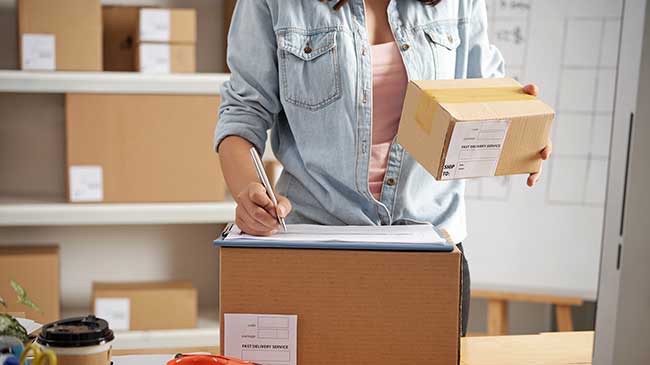E-commerce shipping best practices
A successful e-commerce business is built on a smooth, tightly run shipping process. So everything from packaging to paperwork has to be done to perfection.
However, sending goods to multiple destinations is no easy task – there are different customs procedures and regulations to consider. That’s why we put together this checklist to help you navigate the complex world of international shipping for e-commerce.
The 10-steps checklist for e-commerce shipments
1. Pack your goods properly
It’s crucial packages arrive safely and undamaged to your customers. This can be tricky if the goods have far to travel, but our guide on how to avoid common packing mistakes will help ensure your goods are packed correctly.
When choosing your packaging, it's a good idea to consider the local climate and delivery circumstances. If you're shipping products that vary in size, you may want to look into adjustable packaging like waterproof envelopes for apparel items or adjustable wrap packaging for shipping books.
2. Make sure to label your shipments correctly
When shipping dangerous or fragile goods, or temperature-controlled goods, it's vital to label them correctly. That way you avoid damages, delays or potentially harmful accidents.
Our guide on shipping dangerous goods explains the packaging and documentation required in more detail. For other types of goods, your carrier will be able to provide you with packaging labels and instructions.
3. Find out if your products are regulated
First, check with the local customs authorities if the product you’re shipping is regulated in the destination country. Then find out which authorities regulate it and see what you need to do to comply. Remember, regulations may change, so check for updates regularly.
Not sure where to start? Head to our page on shipping regulated goods for a handy step by step guide.
4. Define who’s responsible for paying duties and taxes
Depending on the goods and their value, duties and taxes may be charged when your shipment clears customs. Either you (the seller), or the receiver can cover these costs.
Not mentioning the duties and taxes is a risky strategy that can lead to a higher number of return shipments from buyers who'll decline to pick up the bill. Transparency is the way to go. Your customers may not mind paying, but they sure don’t want to be surprised with an unexpected bill. Remember to also include the Incoterms defining this agreement on your shipment's commercial invoice.
If you want your customer to cover duties and taxes:
- Add a disclaimer to your web-shop and notify your customers before they complete the payment. This can be a practical solution if you're selling a large number of low-to mid-priced goods.
- Integrate a web-shop tool that will calculate the duties and taxes your customers should expect to pay. This can be useful if you're selling expensive and exclusive products.
- Add duties and taxes to the total amount at check out. Your carrier will need to arrange the payment to the customs authorities and may even be able to advance it for you.
5. State accurate value
Customs use the value to calculate duties and taxes. That’s why it’s important to put down the accurate retail value of the goods on the invoice. If customs doubt the stated value, they may request the customer to provide proof of a transaction or a commercial receipt. They will hold the shipment in the meantime, incurring additional costs.
When stating the value remember to:
- State the quantity of each item using an applicable unit of measurement
- Mention the shipping costs, if these are covered by the customer
- Be clear if discounts are applied. If a discount code was used, you may want to include it on the commercial invoice.
Keep in mind, that undervaluation of goods can result in fines and shipment delays. If customs find your shipments to be repetitively undervalued, the fines may be raised and all your shipments carefully checked by the customs authorities.
6. Prepare the paperwork
Make sure to complete the following documents:
- Always include a commercial invoice complete with a detailed description of your goods, HS code, Incoterms and an accurate commercial value. If the shipping costs were covered by the customer, it's important to state them on the commercial invoice.
- Make sure your air waybill is also complete with shipment details
- Remember to put your full business details such as address and contact information. Keep in mind, some countries require a registered exporter number or proof of e-tailor registration.
- Make sure the recipient details are complete. Some countries require importer identification numbers, like EORI number for the EU based business clients, a PCCC number when shipping to customers based in Korea, or KYC for goods heading to India.
- If you're shipping regulated goods, remember to include the licenses and permits required by the customs authorities
- Check if a proof of origin is required. You may need to provide a certificate of origin, a preferential statement, or both depending on the Free Trade Agreements (FTA) in place.
Just started your e-commerce business? Check out our detailed guide on setting up your e-commerce paperwork.
7. Use electronic documents whenever available
If your country's customs authorities handle documents electronically, registering with them will streamline the procedures for claiming duty relief and benefiting from the preferential agreements.
Through submitting the paperwork online, your carrier will be able to quickly spot incomplete documents and even clear customs before the package reaches the destination country.
8. Monitor your first shipment
Once you've sent your first shipment to a new destination, remember to track its progress. You may want to reach out to your customers to see if they've had any issues with the shipment. If any problems arise, it's important to react quickly and work together with your carrier to make sure the process runs smoothly.
9. Manage customs held shipments
If the goods are not cleared by customs on the day of arrival, they will be held under customs bond. The most common reason for this is a poorly detailed goods description on the commercial invoice. Another is missing contact details of the receiver and, as a result, the carrier not being able to reach out to them for specific clearance instructions.
If your package is held, the carrier will notify you within 24 hours. Unless agreed otherwise, held shipments will usually be returned to the sender after five days, incurring extra costs. Depending on the goods value, shipment volume and the shipping costs, destroying or abandoning goods may be more efficient in some cases. If this is your preferred scenario, remember to notify your carrier in advance.
10. When in doubt, reach out to your carrier
When you're setting up your e-commerce business and figuring out the shipping process, your carrier is your best partner. Reach out to them for advice and support and check out the tools they have on offer to help you streamline the process.
This website is designed to provide general information related to shipping. If you’re unsure of the shipping requirements that apply to you, check with your carrier. Make sure to check the rules and regulations of the country you’re shipping from and to prior to shipping. You can find this information on government websites.


